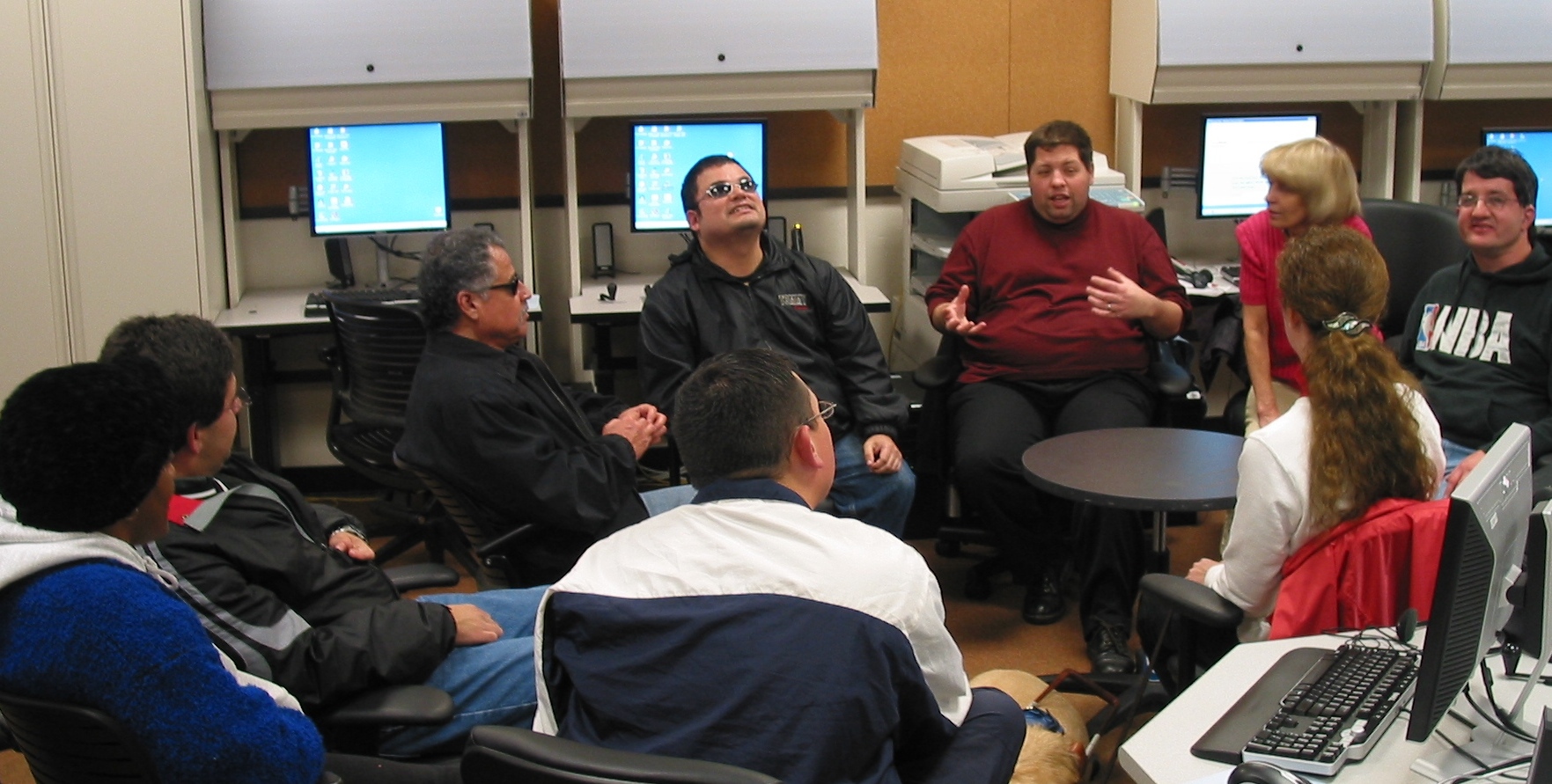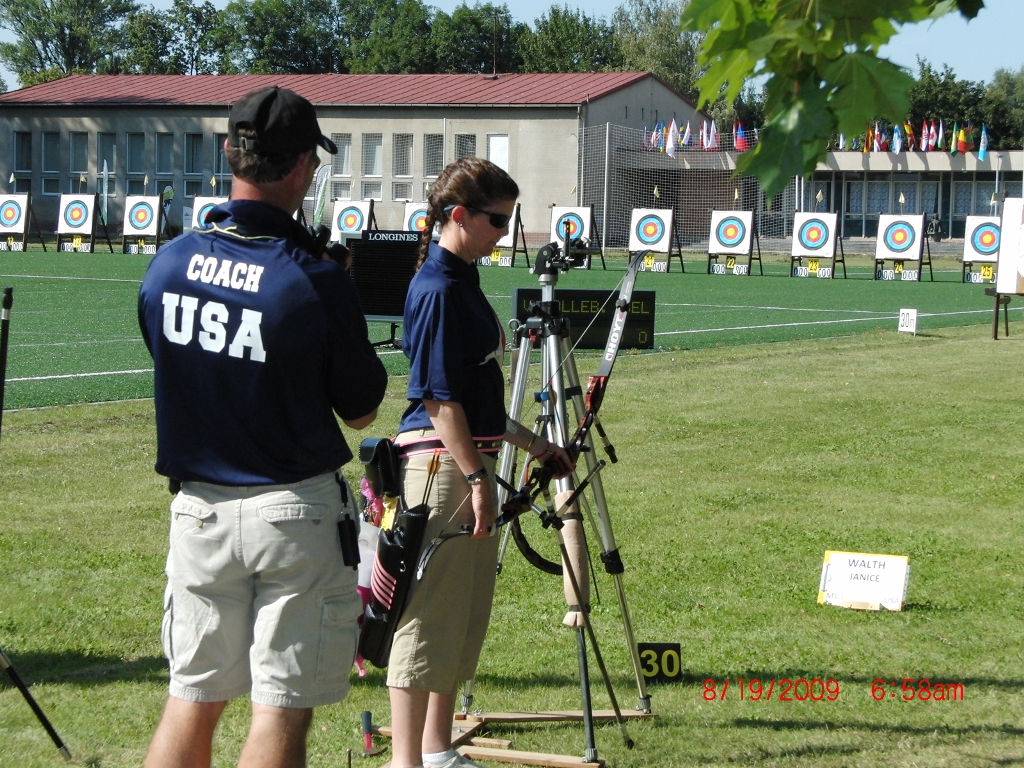|
|
Janice Walth - Background
The Early Years:
I've been blind since childhood with Retinitis Pigmentosa or
R.P., a degenerative condition of the retina. Typically, the disease shows up in
teenagers or adults, but for my brother and me, it showed up early. They
didn't know I had it when I was little. They said we were farsighted.
Back in the '60s, people didn't put a name to it.
When my brother and I were ready to enter elementary school,
my parents and teachers had to decide how we would be taught. Would we
try to read large print or would we be taught Braille? My mom told me
that she and my dad really wanted us to try large print, but after about a half of a year
it became obvious
|
|
|
that my brother wasn’t going to be able to do this, so it was
decided that he would learn Braille. I, on the other hand, was able to
see the large print, so they decided I would go that rout
My brother went on to become an avid reader. Any long
car trips had to include storage space for his volumes of Braille books.
He had a special area of the house, just inside the front door, for the stacks
of shipping boxes that held the volumes of books he was reading. My mom
and younger sister were avid readers too. I, on the other hand, tried to
get interested in reading books, but could never stick with it.
I have memories of trying to read in bed or at my desk, but
being so uncomfortable. I wanted to find a relaxed position like others
who read seemed to enjoy, but couldn’t comfortably hold the book close enough
for extended periods of time or find the right lighting without sitting directly
in front of a lamp or window. If I became motivated enough, I forced
myself to maintain a certain posture and lighting and really tried to pick up
my speed. I picked out a book that really interested me and really
tried. The problem was that I just couldn’t read fast enough. By
|
|
|
the time I reached the end of a sentence, I had forgotten how the sentence had
started. So I started again, and this time went a little faster because I
had already read it once. I just figured I wasn’t doing something right
and had to keep trying. I guess I believed everyone had the same issues
and were able to overcome them with enough practice. The problem was that
I got tired and board and wound up giving up and doing something else that was
more enjoyable. It was enough just to get through my text books. I
didn’t have the desire to keep reading any more than that. |
|
I can only remember finishing two books that I read for
pleasure, before the age of 18. Those books were “Sing Down the Moon” by
Scott O’Dell and “the Upstairs Room” by Johanna Reiss. I really enjoyed
those books and felt such a sense of accomplishment when I finished them. |
|
My coping strategies for reading were to listen to audio
books, but rarely for pleasure because they were too slow and I found something
else to do instead, like listening to albums with my friends. My best
friend would read fan magazines to me and I would look at the pictures.
As I got older, many of my text books were available as
audio books. A combination of large print and audio books got me through college. My typing books were in large print. It’s very
awkward trying to get close enough to the page to read the exercises and keep
your hands placed properly on the keys. Also, I couldn’t read the
exercises as fast as I could type, so I had to memorize the exercises in order
to be able to increase my typing speed and earn a good grade.
|
|
|
I had been typing since the third grade, so typing classes were just a formality that I
needed to get through, but this is when I first started to have problems with
my vision. With the prolonged time spent staring at the typing exercises
in the text book, I began to notice the central vision in my left eye
deteriorating. Nevertheless, I was able to earn my A.S. degree and certificate
in medical transcription.
|
|
|
Starting a Career:
I lost my first transcription job because I was unable to
maintain the required lines per hour. It wasn’t my typing speed that was
the problem, it was that it took me too long to proof my work under the CCTV.
I then found a position at a medical group with a slower
pace and worked my way into a supervisory position, ultimately overseeing
transcription departments for both hospital and medical groups for 18 years.
|
|
This position caused me to use my vision a lot. I used a CCTV for
writing notes, signing off on time sheets and evaluating transcribed medical
reports. I used the first enlarging software designed for
computers. This began to really take a toll on my vision, causing me to
see red blurs periodically. It got to a point where I realized I was
wearing out what vision I had and would really need to switch to a screen
reader if I was to continue to be able to do my job. |
|
This was a turning point in my life. The screen reader
would turn out to be the single most liberating and elevating innovation in my
life. Now I could read faster than my eyes would allow and I was
beginning to discover a whole new world in the way of the internet. In my
personal life, I was able to read the newspaper for the first time and become
familiar with current issues and opinions. I could begin to discuss what
I had read with my family and friends, and form new ideas.
|
|
|
|
Starting Over:
When the hospital closed and I was laid off, I was
encouraged by my family to go back to school. I found myself back at
community college, taking courses in computer science. I had a new way of
studying, using my screen reading software and had all my text books converted
to electronic text. I built up my reading speed and actually felt competitive
with my classmates.
|
|
When I moved to Lodi in 2001, I began working for the
Disability Support Programs and Services department, in the adaptive technology
classroom at San Joaquin Delta College in Stockton, Ca. I became acquainted with students who had the
same difficulties I had previously experienced trying to study efficiently and
read fluently. These students not only had visual difficulties, but had a
variety of disabilities that make learning difficult and challenging. It
was at this time that Ted Wattenberg and I began to work together, trying to
discover the basis for these difficulties and develop strategies for overcoming
them. |
|
I earned my bachelor's degree in assistive technology for
adults with disabilities, taught the advanced computer and screen reading
classes for people who are blind, led small reading groups, and provided other
individualized technology support for students at Delta College. I also
participated on campus teams regarding student and accessibility concerns. I'm
an Independent Service Provider for the Department of Rehabilitation and
currently provide technology support in the larger San Joaquin Valley area.
|
|

|
 |
Hobbies and Community Activities:
My life is infused with family, career and volunteering with several community organizations. My husband, Courtney, and I are passionate about the sport of archery and are working on forming a nonprofit organization called See No Limits that will encourage youth and adults who are visually impaired to try out and hopefully become competitive in the sport. Courtney and I compete in archery tournaments together; I shoot under the visually impaired category. I've participated in two world championships and hold world records and I am ranked 3rd in the world. Courtney sets up my equipment and helps me with the initial sighting in, and then its up to me to maintain good form like any other archer.
|
| In addition to archery, we have been active in Discovery Blind Sports (DBS) for over 8 years. This non-profit organization organizes and leads snow skiing experiences for people who are blind. Courtney is a licensed ski guide for DBS. I am currently the President of the Board of Directors |
|
|
|